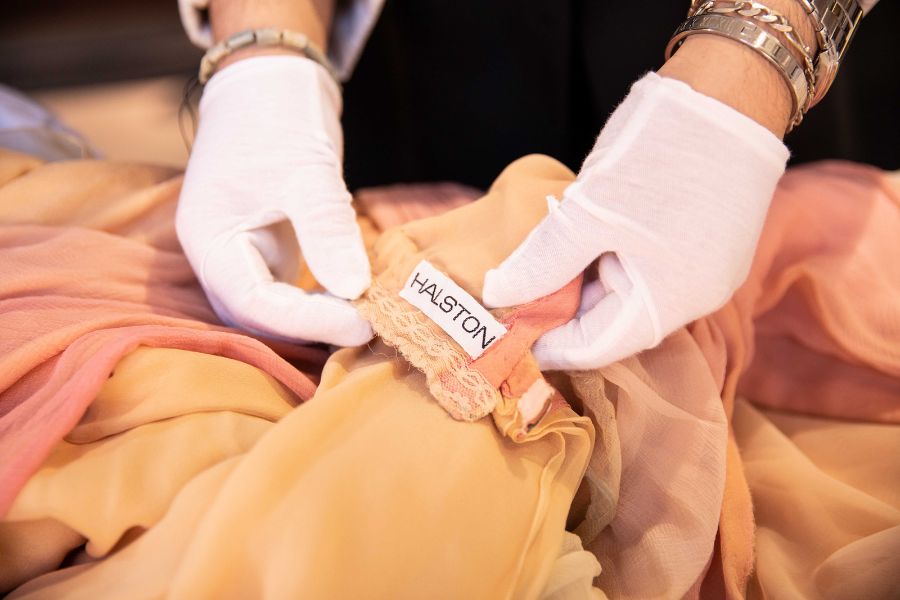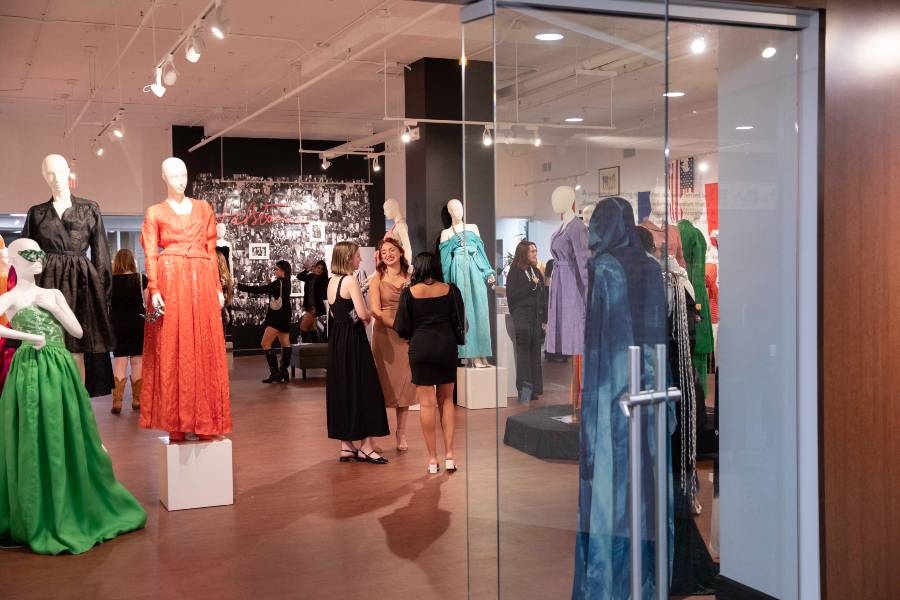Halston Collection inspires future fashion trendsetters
Janel Shoun-Smith |

In order to become a trendsetting future fashion leader, one would do well to look to the fashion titans of the past who pioneered new trends that now are ever-present.
Lipscomb’s students in the Department of Fashion and Design have the unique opportunity to ground their own future creative innovation in the work of Roy Frowick Halston, an American designer known simply as Halston, who “changed the face of women’s wear as we know it,” said Charlotte Poling, assistant professor in the Department of Fashion and Design.
This fall, the department focused on the fashions of Halston and gave the Lipscomb community the chance to learn more about the designer at Fashion Week 2024 Oct. 21-25. The week featured a series of events that culminated in the opening of The Halston Narrative: Yesterday, Today and Tomorrow fashion exhibition, which was part of the 2024-25 Presidential Signature Series. The exhibition runs through the first week of December.

Charlotte Poling looks at the Halston exhibition with his niece Lesley Frowick.

Students viewed the fashions of Halston at a black-tie gala during Fashion Week.
Lipscomb University is home to one of the most comprehensive collections of famed designer Halston. The Fashion Week exhibition featured watercolors from Halston’s studio, photographs of historical and aesthetic importance, media clips from the collection and a sampling of the garments that highlight some of Halston’s greatest work. As a special feature, Halston's niece, Lesley Frowick, shared her experiences with her famed uncle in her talk, “Halston, the Man behind the Black Turtleneck.” The week ended with a black tie gala for students focused on the theme “Halston Disco Masquerade Gala."

Sissy Simmons, department chair, developed the required course Design Studio with a section on fashion design that allows students to actually hold and analyze Halston’s original patterns and create their own fashion designs inspired by what they can see, touch and analyze in-person.
Such hands-on learning is available thanks to the Lipscomb Halston Collection, an archive of garments, patterns and the business documents of Halston, donated to Lipscomb’s fashion merchandising department by Georgette Mosbacher, president and CEO of Borghese Cosmetics in New York City.

Sissy Simmons
The collection includes more than 800 watercolor sketches, hundreds of patterns, mood boards, countless business documents and communications, photographs, press clippings and TV broadcasts, as well as more than 60 garments, including a large selection of evening dresses.
“These are original patterns that were literally drawn on; they have been sketched on; you can see Halston's handwriting on it; there are original markings on it,” said Poling. “A lot of the time they have original swatches that have been pinned on.
“Most of the patterns in the collection are couture, specific to one person, such as Liza Minnelli, Kathryn Graham; all the greats that he dressed,” she said.
Halston designed the pillbox hat worn by Jackie Kennedy at President John F. Kennedy’s inaugural in 1961; was the first to use print models in runway shows, a precursor to the “supermodel;” designed for Hollywood celebrities such as Liz Taylor, Lucille Ball, Lauren Bacall and Princess Grace, and was named by Gucci’s Tom Ford and Donna Karan as a major influence on their style.

Charlotte Poling
Fashion students studied the patterns in the classroom and were assigned to either recreate the historical garment or to do a modern adaptation of their own based off of the pattern. For Lipscomb’s fashion week in fall 2021, fashion, art and history students came together to host an exhibit of selected pieces from the Halston collection as well as the student-designed garments inspired by Halston patterns.
“He had such innovative ways of making patterns and constructing clothes. So this exercise gave students exposure to another way of making patterns, another way of draping fabric,” said Simmons. “It gave them the opportunity to see how even a very simple pattern can be made special through fabric choice and craftsmanship. That’s what made his clothes special.”
Until Halston hit the scene in the 1960s and ’70s, women’s wear was much more structural, fabrics worn close to the body and not necessarily comfortable, Poling said. “His look was soft and drapey, comfortable and glamorous,” a look that has become common for today’s woman, said Poling.
Last year, Poling took all that she and Simmons have learned about using the collection in the classroom to prepare a proposal about best practices for the Fashion Institute of Technology’s fall conference titled Archiving Fashion Conference: Mapping Fashion Collections. The proposed panel discussion included a student who was involved in the Design Studio course Halston exercise.
In addition to being what some have called “a national treasure,” Lipscomb’s Halston collection promises to spur years of in-depth study among students in the business of fashion, change-making and market disruption.